Un approccio sorridente e divertito nei confronti della realtà e della società attuali costituisce uno dei tanti modi per gli artisti di trattare temi contemporanei che non possono essere esclusi dall’osservazione di tutto ciò che circonda, e appartiene, al vivere moderno. In questo caso ovviamente la drammaticità e le ansie che potrebbero generarsi nel lasciar fuoriuscire criticità e problemi che fanno parte del presente, vengono abbandonati per mettere in evidenza invece il lato più ludico, piacevole, senza che questo implichi superficialità bensì riuscendo ad alleggerire sensazioni ed emozioni che pur esistendo perdono la loro accezione di gravità inducendo l’osservatore a non porsi in posizione di chiusura o di difesa. L’artista di cui vi racconterò oggi analizza le attitudini e le abitudini dell’individuo contemporaneo attribuendone gli atteggiamenti ad animali con le fattezze umane, generando una sensazione burlesca da cui l’osservatore non può che essere curiosamente attratto.
Fin dall’antichità l’uomo ha sempre cercato di ricondurre alla propria morfologia tutte le figure irreali e immaginarie oppure spirituali che costituivano le entità soprannaturali delle religioni; in particolare in quelle politeiste molte divinità erano raccontate con teste animali e corpi umani, come ad esempio nell’antico Egitto nella rappresentazione di Anubi di cui sono state rinvenute molte incisioni all’interno delle piramidi, proprio per sottolinearne la forza e i poteri sovrannaturali. Nella mitologia greca furono molte le scritture rinveute in cui semidei per metà umani e per metà animali, come il Minotauro e i Satiri dionisiaci, fungevano da minaccia o da speranza di salvezza per gli errori degli uomini su cui vegliavano gli dei; questa lunga tradizione antropomorfa si diffuse anche nelle favole, come nel caso di Esopo e poi, nei tempi più recenti e assumendo un’accezione decisamente più giocosa, nella narrativa per ragazzi di Lewis Carrol e Beatrix Potter. L’arte, da sempre in armonia con il sentire dei tempi e allineata con i gusti estetici e morali della società, e anche dei committenti, ha trascurato questo tipo di rappresentazione visiva fino alla metà dell’Ottocento, quando cioè il Simbolismo si propose di esplorare tutte le energie sottili intorno all’essere umano, il rapporto con il divino che aleggiava nella realtà senza che l’individuo ne fosse consapevole, e soprattutto raccontando tutte quelle tradizioni mitologiche del lontano passato in cui l’antropomorfismo era simbolo di divinità e di forza. Gustave Moreau e Arnold Böcklin dipinsero meravigliose tele di cui erano protagoniste figure leggendarie e inquietanti e anticiparono la fantasia e l’irrealtà assoluta del successivo Surrealismo, dove tutte le certezze rappresentative erano messe in secondo piano rispetto alla necessità di far emergere l’inquietudine del sogno e degli incubi; Max Ernst, Yves Tanguy e l’italiano Alberto Savinio furono gli esponenti che più di tutti ripresero la tendenza ad associare la forma umana a teste di animali o viceversa, sempre però rimanendo all’interno delle linee guida del movimento, e dunque raccontando le angosce generate dall’inconscio. Nel Surrealismo contemporaneo le accezioni più estreme degli autori del Novecento vengono abbandonate e mescolate alle tematiche più centrali del vivere moderno, al lasciar emergere aspetti a volte persino più inquietanti ma presentati con un aspetto quasi innocente, come nelle opere del Lowbrow, oppure più ironiche e irriverenti in cui si mescola uno sguardo Pop alle rappresentazioni anche immaginarie dell’osservato.
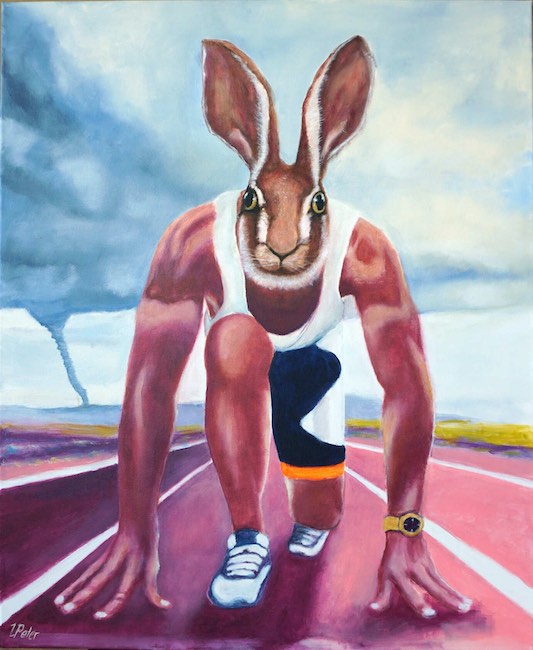
È proprio quest’ultimo l’approccio che contraddistingue l’artista tedesca Utaellamarie Peter la quale mescola la tradizione a uno sguardo differente, più ironico, meno cupo ma altrettanto sagace e analitico sulla realtà contemporanea, modernizzando e riproducendo abitudini e atteggiamenti dell’uomo a cui vengono però attribuite teste animali, come se in qualche modo volesse sensibilizzare il fruitore sulla rilevanza che di fatto essi hanno nella vita umana, o quanto poche siano le differenze se si scrutano i loro atteggiamenti spontanei. Da un altro punto di vista però, forse quella compiuta da Utaellamarie Peter è un’analisi divertente su alcuni personaggi, o sarebbe meglio dire delle loro pose e delle loro scelte, a cui in qualche modo sente la necessità di avvicinare le caratteristiche che nell’immaginario comune vengono associate ad alcune razze animali.
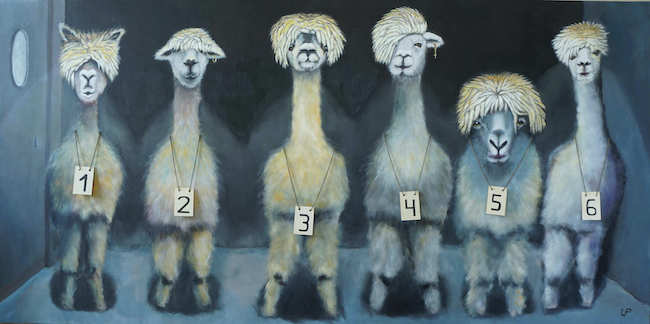
Lo stile espressivo è realista, così come la scelta cromatica, sempre affine alle ambientazioni scelte, ma l’aspetto generale non può non essere collegato al Surrealismo proprio in virtù dell’irrealtà dell’aspetto dei soggetti narrati, quell’antropomorfismo che in lei perde completamente il signficato legato alla religione e alla spiritualità tipiche del passato precristiano per divenire un derisorio sguardo sulla quotidianità attuale, mostrando la capacità di Utaellamarie Peter di infondere di umorismo tutto ciò su cui riflette e su cui la sua attenzione artistica sceglie di concentrarsi. In questo forse si avvicina ai dipinti divertenti di Cassius Marcellius Coolidge, dove i cani assumono comportamenti umani giocando addirittura a pocker, lasciando intravedere nelle sue opere la medesima giocosa ironia attraverso la quale immaginare un mondo in cui tutto potrebbe essere rovesciato; oppure al contrario quello della Peter è un sottile auspicio che la razza umana possa progredire ed evolvere prendendo il meglio dagli animali e trasformandosi in un’entità più elevata, morfologicamente modificata ma forse migliore poiché la direzione che sta prendendo nella contemporaneità non sembra tendere verso un’evoluzione.

In Bunny l’artista evidenzia la sensualità che da sempre è legata in qualche modo nell’immaginario comune alla femmina del coniglio, scelta come simbolo per una nota rivista maschile in cui il corpo e le pose provocatorie sono protagoniste assolute; qui la movenza è seducente, il corpo avvenente e la testa è appunto quella di una coniglietta consapevole del suo fascino, sicura di sé e in atteggiamento da femme fatale. In qualche modo l’artista sdrammatizza la tendenza di alcune donne a prendersi troppo sul serio, ricordando quanto anche le dive degli anni Cinquanta del Novecento fossero in grado di ridere di sé, contrariamente alle ragazze attuali, talmente preoccupate di migliorare il proprio aspetto tramite le applicazioni dei cellulari da votarsi esclusivamente all’inseguimento del benessere e della bellezza esteriore, perdendo dunque l’autoironia e la capacità di accettare le proprie debolezze e i propri difetti.
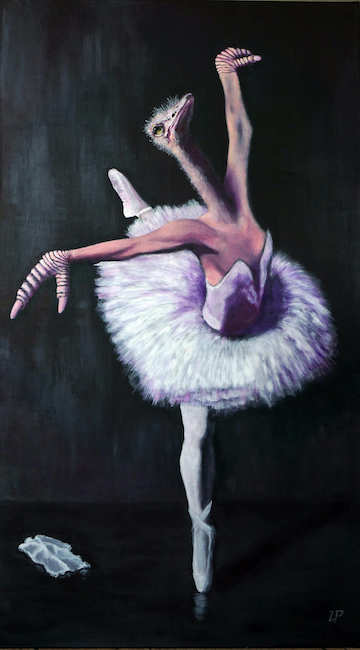
In Prima, Donna invece viene evidenziato l’aspetto dello struzzo così simile a quello di una ballerina da essere facilmente associabile alla danza classica, all’armonia e alla leggerezza con cui le interpreti del balletto si muovono sul palco tanto quanto quella con cui lo struzzo corre nella savana; la maestosità della posa ricorda i quadri di Degas ma l’irriverenza che appartiente a Utaellamarie Peter la induce a sdrammatizzare il momento indugiando sul volto serioso, e proprio per questo comico, della madame struzzo concentrata nella perfetta esecuzione del movimento.
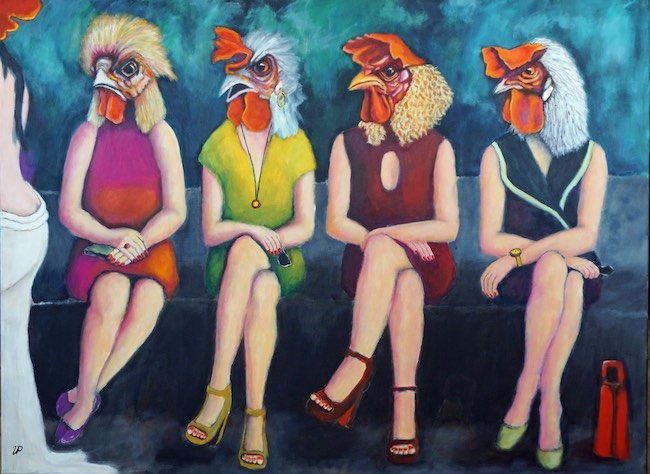
In Front row with Kim Kardashian l’artista raffigura donne con la testa di gallina in prima fila, come sottolineato dal titolo, durante una sfilata di moda, con le loro pose eleganti ma impersonali, quasi volesse far sottilmente emergere la superficialità di un mondo luccicante ma spesso vuoto; l’idea di associare la gallina, abitualmente riconducibile dal punto di visto simbolico alla mancanza di intelligenza, vuole probabilmente essere un modo per esprimere il suo punto di vista sulla direzione della società attuale, troppo spesso orientata a considerare e privilegiare l’involucro a discapito dei contenuti. Le espressioni delle quattro protagoniste sembrano infatti enfatizzare la mancanza di emozione, l’attenzione all’apparire importanti solo e unicamente in virtù di quei posti privilegiati per assistere a uno spettacolo che non costituirà mai un arricchimento interiore.
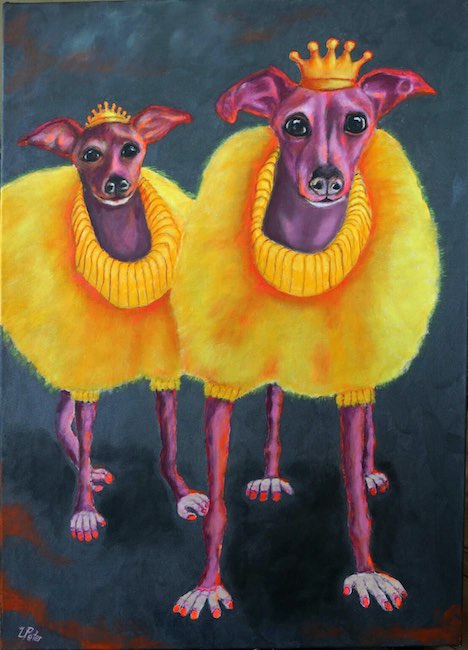
Altra caratteristica affascinante dello stile pittorico di Utaellamarie Peter è quella di dirigere lo sguardo degli animali di alcuni dipinti direttamente verso l’osservatore, come se da un lato volessero mettere in evidenza quante similitudini vi sarebbero se solo loro avessero la possibilità di emanciparsi dai ruoli a cui sono relegati, mentre dall’altro fossero curiosi nei confronti di una razza diversa, quella appunto dell’uomo, che sembra essere passata perché l’evoluzione compiuta ha condotto verso una fusione di generi e una modificazione radicale per cui ciò che c’era prima è solo un ricordo.
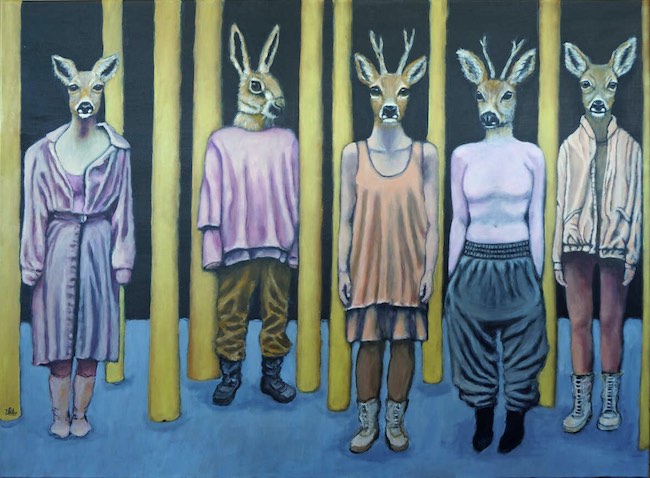
In questa particolare accezione Utaellamarie Peter si interroga sui cambiamenti che l’uomo sta subendo, sulla direzione verso cui sta andando, verso una disumanizzazione che potrebbe essere fermata se si rivolgesse a un maggiore contatto con la natura divenendo così migliore. Utaellamarie Peter, che ama misurarsi con diverse serie pittoriche, ha al suo attivo un interessante percorso espositivo in Germania e all’estero – Parigi, Bologna, Milano, Roma – ed è membro di varie associazioni artistiche nazionali e internazionali.
UTAELLAMARIE PETER-CONTATTI
Email: utaellamarie.peter@t-online.de
Sito web: www.utaellamarie-peter.de/wordpress/
Facebook: www.facebook.com/utaellamarie.peter
Instagram: www.instagram.com/utaellamarie.peter/
Utaellamarie Peter’s surreal hybrid figures, between ironic downplaying and penetrating reflection on the hypothetical future of humanity
A smiling and amused approach to current reality and society constitutes one of the many ways for artists to deal with contemporary issues that cannot be excluded from the observation of everything that surrounds, and belongs to, modern living. In this case, obviously, the drama and anxieties that could be generated in letting out critical issues and problems that are part of the present are abandoned in order to highlight instead the more playful, pleasant side, without this implying superficiality but rather succeeding in lightening sensations and emotions that while existing lose their sense of seriousness inducing the observer not to place himself in a position of closure or defense. The artist I am going to tell you about today analyzes the attitudes and habits of the contemporary individual by attributing their deportments to animals with human features, generating a burlesque feeling to which the observer cannot help but be curiously attracted.
Since antiquity man has always tried to trace back to his own morphology all the unreal and imaginary or spiritual figures that constituted the supernatural entities of the religions; particularly in the polytheistic ones many deities were told with animal heads and human bodies, as for example in ancient Egypt in the representation of Anubis of whom many engravings have been found inside the pyramids, precisely to emphasize his supernatural strength and powers. In Greek mythology there were many revived writings in which half-gods who were half-human and half-animal, such as the Minotaur and the Dionysian Satyrs, acted as a threat or hope of salvation for the errors of the men over whom the gods watched; this long anthropomorphic tradition also spread to fables, as in the case of Aesop and then, in more recent times and taking on a decidedly more playful meaning, to the children’s novels of Lewis Carrol and Beatrix Potter. Art, which has always been in harmony with the feeling of the times and aligned with the aesthetic and moral tastes of society, and also of patrons, neglected this type of visual representation until the mid-19th century, that is, when Symbolism set out to explore all the subtle energies around the human being, the relationship with the divine that hovered in reality without the individual being aware of it, and above all by recounting all those mythological traditions of the distant past in which anthropomorphism was a symbol of divinity and strength.
Gustave Moreau and Arnold Böcklin painted marvelous canvases whose protagonists were legendary and disturbing figures and anticipated the fantasy and absolute unreality of the later Surrealism, where all representational certainties were put in second place to the need to bring out the restlessness of dreams and nightmares; Max Ernst, Yves Tanguy and the Italian Alberto Savinio were the exponents who most of all took up the tendency to associate the human form with animal heads or vice versa, always, however, remaining within the guidelines of the movement, and thus recounting the anxieties generated by the unconscious. In contemporary Surrealism, the more extreme meanings of the twentieth-century authors are abandoned and mixed with the more central themes of modern living, to the letting emerge aspects that are sometimes even more disturbing but presented with an almost innocent appearance, as in the artworks of Lowbrow, or more ironic and irreverent in which a Pop look is mixed with even imaginary representations of the observed. It is precisely the latter approach that distinguishes German artist Utaellamarie Peter who mixes tradition with a different, more ironic, less somber but equally shrewd and analytical look at contemporary reality, modernizing and reproducing human habits and attitudes to which, however, animal heads are attributed, as if somehow she wanted to make the viewer aware of the relevance they in fact have in human life, or how few differences there are if one scrutinizes their spontaneous attitudes. From another point of view, however, perhaps that accomplished by Utaellamarie Peter is an amusing analysis of certain characters, or it would be better to say of their poses and choices, to which she somehow feels the need to approximate the characteristics that in the common imagination are associated with certain animal breeds.
The expressive style is realist, as is the chromatic choice, always akin to the chosen settings, but the overall appearance cannot but be linked to Surrealism precisely because of the unreality of the appearance of the subjects narrated, that anthropomorphism that in her completely loses the signficance related to religion and spirituality typical of the pre-Christian past to become a derisive look at present-day everyday life, showing Utaellamarie Peter‘s ability to infuse with humor everything on which she reflects and on which her artistic focus chooses to concentrate. In this perhaps she approaches the amusing paintings of Cassius Marcellius Coolidge, where dogs take on human behavior by even playing pocker, hinting in her works at the same playful irony through which she imagines a world in which everything could be turned upside down; or on the contrary that of Utaellamarie Peter is a subtle wish that the human race could progress and evolve by taking the best from animals and transforming itself into a higher entity, morphologically modified but perhaps better since the direction it is taking in contemporary times does not seem to be trending toward evolution. In Bunny, the artist highlights the sensuality that has always been somehow linked in the common imagination to the female rabbit, chosen as a symbol for a well-known men’s magazine in which the body and provocative poses are the absolute protagonists; here the movement is seductive, the body comely and the head is precisely that of a bunny aware of her charm, confident and in a femme fatale attitude. Somehow the artist downplays the tendency of some women to take themselves too seriously, reminding us how even the divas of the 1950s were able to laugh at themselves, in contrast to today’s girls, so concerned with improving their appearance through cell phone apps that they devote themselves exclusively to the pursuit of well-being and outward beauty, thus losing self-mockery and the ability to accept their weaknesses and flaws. In Prima, Donna, on the other hand, the appearance of the ostrich is highlighted that is so similar to that of a ballerina as to be easily associated with ballet, the harmony and lightness with which the ballet performers move on stage as much as that with which the ostrich runs through the savannah; the majesty of the pose is reminiscent of the paintings of Degas but the irreverence that belongs to Utaellamarie Peter causes her to downplay the moment by lingering on the serious, and for that very reason comical, face of the madame ostrich focused on the perfect execution of the movement.
In Front row with Kim Kardashian, the artist depicts hen-headed women in the front row, as emphasized by the title, during a fashion show, with their elegant but impersonal poses, as if she wanted to subtly bring out the superficiality of a glittering but often empty world; the idea of associating the hen, habitually symbolically ascribable to a lack of intelligence, is probably meant to be a way of expressing her point of view on the direction of today’s society, too often oriented toward considering and privileging the envelope at the expense of content. Indeed, the expressions of the four protagonists seem to emphasize the lack of emotion, the focus on appearing important only and solely by virtue of those privileged places to watch a spectacle that will never constitute inner enrichment. Another fascinating characteristic of Utaellamarie Peter‘s painting style is that of directing the gaze of the animals in some of the paintings directly toward the viewer, as if on the one hand they wanted to highlight how many similarities there would be if only they had the chance to emancipate themselves from the roles to which they are relegated, while on the other hand they were curious about a different race, that of man precisely, which seems to have passed because the evolution accomplished has led toward a fusion of genders and a radical modification so that what was there before is only a memory. In this particular sense, Utaellamarie Peter questions the changes that man is undergoing, the direction in which he is going, toward a dehumanization that could be stopped if he turned to greater contact with nature thus becoming better. Utaellamarie Peter, who loves to compete with different pictorial series, has to her credit an interesting exhibition career in Germany and abroad – Paris, Bologna, Milan, Rome – and is a member of various national and international art associations.













